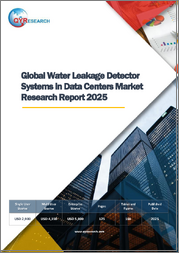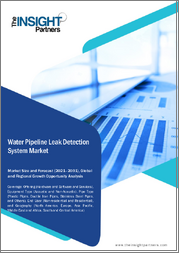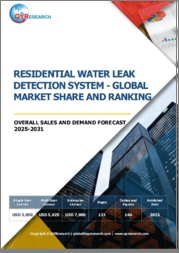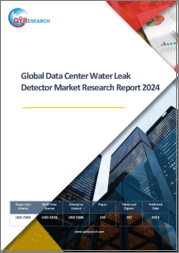
|
시장보고서
상품코드
1660936
수도관 누수 감지 시스템 시장 보고서 : 기술, 장치, 파이프 유형, 최종 용도, 지역별(2025-2033년)Water Pipeline Leak Detection System Market Report by Technology, Equipment, Pipe Type, End-Use, and Region 2025-2033 |
||||||
수도관 누수 감지 시스템 세계 시장 규모는 2024년에 26억 달러에 달했습니다. 향후 IMARC Group은 시장이 2033년까지 41억 달러에 이르며 2025년부터 2033년까지 5.5%의 성장률(CAGR)을 나타낼 것으로 예측했습니다. 물 부족에 대한 환경 문제에 대한 관심 증가, 배수 네트워크에 대한 귀중한 데이터와 통찰력을 제공하기 위한 채택 증가, 상업 공간 증가 등이 시장을 추진하는 주요 요인의 일부입니다.
수도관 누수 감지 시스템은 급수 네트워크에서 누수를 식별하고 위치를 확인하도록 설계된 정교한 인프라입니다. 그것은 물을 절약하고 물 손실을 방지하고 누수로 인한 잠재적 손해를 줄이는 데 중요한 역할을 합니다. 음향 센서, 유량계, 압력 센서 등의 고급 기술을 활용하여 파이프라인의 무결성을 모니터링합니다. 수자원 관리 개선, 물 낭비 감소, 파이프 파열로 인한 지역사회 혼란 최소화 등 몇 가지 장점이 있습니다. 환경보전 노력에 기여하여 도시와 농촌에서의 책임있는 물 사용을 촉진할 수 있습니다.
물 부족과 지하 수위 저하에 대한 환경 문제 증가는 세계 시장의 성장을 강화하고 있습니다. 게다가, 배수 네트워크에 대한 귀중한 데이터와 통찰력을 제공하고 정보를 기반으로 한 의사결정과 보다 나은 인프라 계획을 가능하게 하는 수도관 누수 감지 시스템의 채용이 증가하고 있는 것도 시장 성장을 뒷받침하고 있습니다. 게다가, 물의 사용을 최적화하고 낭비를 최소화하기 위한 스마트 물 관리 시스템에서의 수도관 누수 감지 시스템의 통합이 시장 성장에 기여하고 있습니다. 이 외에도 공항, 병원, 호텔, 레스토랑, 카페, 리조트, 유원지, 사무실, 쇼핑몰 등 상업 공간 증가가 시장에 긍정적인 영향을 미칩니다. 또한 수처리 시설에 대한 수요가 증가하고 정밀한 배수망을 제공하기 위한 물과 그 효과적인 관리에 대한 요구가 높아지면서 시장 성장을 가속하고 있습니다.
수도관 누수 감지 시스템 시장 동향 및 촉진요인:
물 손실에 대한 우려 증가
물 부족과 효율적인 물 관리의 필요성은 세계적으로 중요한 과제가 되고 있습니다. 노후화된 파이프라인 인프라의 누수로 인한 물 손실에 대한 우려 증가는 누수 감지 시스템에 대한 수요를 강화하고 있습니다. 비효율적인 배수 시스템은 상당한 물 낭비, 운영 비용 증가, 잠재적인 환경 파괴로 이어집니다. 수도 및 수자원 당국은 손실을 최소화하고 귀중한 수자원을 절약하기 위해 고급 누수 감지 솔루션에 대한 투자를 늘리고 있습니다. 이러한 시스템은 파이프라인의 실시간 모니터링을 가능하게 하고, 누수를 신속하게 파악하고, 적시에 수리를 가능하게 함으로써, 물 부족의 영향을 완화하고 지속 가능한 물 관리 관행에 기여합니다.
엄격한 지침
세계 정부와 규제기관은 물의 보전과 인프라 관리를 위해 엄격한 지침을 부과하고 있습니다. 이러한 규정을 준수하는 것은 수도 사업자와 기업에 있어서 매우 중요한 요소가 되고 있습니다. 수도관 누수 감지 시스템은 조기 누수 감지 기능을 제공함으로써 조직이 이러한 의무에 대응할 수 있도록 지원합니다. 규제 요건을 준수하는 것은 벌칙을 피할 뿐만 아니라, 책임감이 있어 환경에 배려한 기업으로서의 평판을 높입니다. 그 결과 이러한 시스템에 대한 수요가 급증하고 있습니다. 기업은 사업을 유지하고 사회적 신용을 유지하기 위해 진화하는 컴플라이언스 기준에 적극적으로 대응하려고 하기 때문입니다.
인프라 노후화와 열화 증가
많은 나라가 본래의 수명을 넘어서는 수도 인프라의 노후화에 임하고 있습니다. 파이프라인은 시간이 지남에 따라 열화되어 누수와 파열의 가능성이 크게 증가합니다. 수도관 누수 감지 시스템은 노후화된 인프라의 상태를 감시·평가하는데 중요한 역할을 합니다. 이러한 시스템은 누수와 잠재적인 취약성을 신속하게 감지할 수 있으므로 적시에 수리가 가능하며 파이프라인을 지속적으로 모니터링하여 치명적인 고장을 방지할 수 있습니다. 정부와 유틸리티자가 수도 인프라의 업그레이드와 유지에 투자하는 동안 노후화된 시스템에 의해 야기되는 과제를 해결하기 위해 최신 누수 감지 솔루션에 대한 수요가 계속 증가하고 있습니다.
목차
제1장 서문
제2장 조사 범위와 조사 방법
- 조사의 목적
- 이해관계자
- 데이터 소스
- 1차 정보
- 2차 정보
- 시장 추정
- 상향식 접근
- 하향식 접근
- 조사 방법
제3장 주요 요약
제4장 소개
- 개요
- 주요 업계 동향
제5장 세계의 수도관 누수 감지 시스템 시장
- 시장 개요
- 시장 실적
- COVID-19의 영향
- 시장 예측
제6장 시장 분석 : 기술별
- 초음파
- 시장 동향
- 시장 예측
- 스마트볼
- 시장 동향
- 시장 예측
- 자속
- 시장 동향
- 시장 예측
- 광섬유
- 시장 동향
- 시장 예측
- 기타
- 시장 동향
- 시장 예측
제7장 시장 분석 : 장치별
- 음향
- 시장 동향
- 시장 예측
- 비음향
- 시장 동향
- 시장 예측
제8장 시장 분석 : 파이프 유형별
- 플라스틱 파이프
- 시장 동향
- 시장 예측
- 덕타일 주철관
- 시장 동향
- 시장 예측
- 스테인리스 스틸관
- 시장 동향
- 시장 예측
- 알루미늄 파이프
- 시장 동향
- 시장 예측
- 기타
- 시장 동향
- 시장 예측
제9장 시장 내역: 최종 용도별
- 산업
- 시장 동향
- 시장 예측
- 주택용
- 시장 동향
- 시장 예측
- 상업용
- 시장 동향
- 시장 예측
- 시영
- 시장 동향
- 시장 예측
제10장 시장 분석 : 지역별
- 북미
- 미국
- 캐나다
- 유럽
- 독일
- 프랑스
- 이탈리아
- 스페인
- 폴란드
- 영국
- 기타
- 아시아태평양
- 중국
- 일본
- 한국
- 인도
- 호주
- 기타
- 중동 및 아프리카
- 터키
- 사우디아라비아
- 아랍에미리트(UAE)
- 이스라엘
- 기타
- 라틴아메리카
- 브라질
- 멕시코
- 기타
제11장 SWOT 분석
- 개요
- 강점
- 약점
- 기회
- 위협
제12장 밸류체인 분석
제13장 Porter's Five Forces 분석
- 개요
- 구매자의 협상력
- 공급기업의 협상력
- 경쟁도
- 신규 참가업체의 위협
- 대체품의 위협
제14장 경쟁 구도
- 시장 구조
- 주요 기업
- 주요 기업 프로파일
- Mueller Water Products Inc
- NEC Corporation
- Xylem, Inc.
- SPX Corporation
- Gutermann AG.
- Badger Meter Inc.
- ABB Ltd.
- 3M Company
- Perma-Pipe International Holdings, Inc
The global water pipeline leak detection system market size reached USD 2.6 Billion in 2024. Looking forward, IMARC Group expects the market to reach USD 4.1 Billion by 2033, exhibiting a growth rate (CAGR) of 5.5% during 2025-2033. The increasing environmental concerns about water scarcity, rising adoption to provide valuable data and insights about water distribution networks, and the growing number of commercial spaces are some of the major factors propelling the market.
A water pipeline leak detection system is a sophisticated infrastructure designed to identify and locate leaks in water supply networks. It plays a crucial role in conserving water, preventing water loss, and reducing potential damages caused by leaks. It utilizes advanced technologies like acoustic sensors, flow meters, and pressure sensors to monitor the integrity of the pipeline. It offers several benefits, including improved water resource management, reduced water wastage, and minimized disruption to communities due to burst pipes. It can contribute to environmental conservation efforts and promote responsible water usage in urban and rural areas.
The increasing environmental concerns about water scarcity and decreasing groundwater levels are strengthening the growth of the market around the world. Moreover, the rising adoption of water pipeline leak detection systems to provide valuable data and insights about water distribution networks, which enables informed decision-making and better infrastructure planning, is favoring the growth of the market. In addition, the integration of water pipeline leak detection systems in smart water management systems to optimize water use and minimize waste is contributing to the market growth. Apart from this, the growing number of commercial spaces, such as airports, hospitals, hotels, restaurants, cafes, resorts, amusement parks, offices, and shopping malls, is influencing the market positively. Furthermore, the increasing demand for water treatment facilities and the rising need for water and its effective management to provide a well-structured distribution network is propelling the growth of the market.
Water Pipeline Leak Detection System Market Trends/Drivers:
Increasing concerns about water loss
Water scarcity and the need for efficient water management have become critical global challenges. Rising concerns over water loss due to leaks in aging pipeline infrastructure have intensified the demand for leak detection systems. Inefficient water distribution systems lead to substantial water wastage, increased operational costs, and potential environmental damage. Utilities and water authorities are increasingly investing in advanced leak detection solutions to minimize losses and conserve precious water resources. These systems enable real-time monitoring of pipelines, promptly identifying leaks, and enabling timely repairs, thus mitigating the impact of water shortages and contributing to sustainable water management practices.
Stringent guidelines
Governments and regulatory bodies worldwide are imposing stringent guidelines to address water conservation and infrastructure management. Compliance with these regulations has become a crucial factor for water utilities and companies. Water pipeline leak detection systems help organizations meet these mandates by providing early leak detection capabilities. Adhering to regulatory requirements not only avoids penalties and also enhances the reputation of the company as a responsible and environmentally conscious entity. Consequently, the demand for such systems has surged, as companies seek to proactively align with evolving compliance standards to sustain their operations and maintain public trust.
Increase in infrastructure ageing and deterioration
Many countries are grappling with ageing water infrastructure that has surpassed its intended lifespan. As pipelines deteriorate over time, the likelihood of leaks and bursts increases significantly. Water pipeline leak detection systems play a crucial role in monitoring and assessing the condition of ageing infrastructure. These systems can promptly detect leaks and potential vulnerabilities, which enables timely repairs and prevents catastrophic failures by continuously monitoring the pipelines. As governments and utility providers invest in upgrading and maintaining their water infrastructure, the demand for modern leak detection solutions continues to rise to address the challenges posed by ageing systems.
Water Pipeline Leak Detection System Industry Segmentation:
Breakup by Technology:
- Ultrasonic
- Smart Ball
- Magnetic Flux
- Fiber Optic
- Others
Ultrasonic dominates the market
Smart ball technology, also known as inline inspection or pigging, employs a small, intelligent device (the smart ball) that is inserted into the pipeline and travels along with the flow of water. It is equipped with sensors and communication capabilities, the smart ball records various parameters like pressure, temperature, and flow rates while it moves through the pipeline. It can immediately transmit real-time data, allowing operators to pinpoint the location of the leak.
Breakup by Equipment:
- Acoustic
- Non-Acoustic
Non-acoustic holds the largest share in the market
Acoustic equipment is a crucial component of a water pipeline leak detection system. It consists of specialized sensors or microphones that are strategically placed along the pipeline route to capture and analyze sound waves generated by water leaks. The acoustic sensors can pick up these sounds, even if they are faint or not audible to the human ear.
Breakup by Pipe Type:
- Plastic Pipes
- Ductile Iron Pipes
- Stainless Steel Pipes
- Aluminium Pipes
- Others
Ductile iron pipes dominate the market
Plastic pipes, such as polyvinyl chloride (PVC) or high-density polyethylene (HDPE), are commonly used in water distribution systems. These pipes are generally non-metallic, which makes traditional acoustic leak detection challenging since they don't transmit sound and metallic pipes.
Stainless steel pipes are also used in water distribution systems, especially in corrosive environments. Stainless steel pipes allow for effective acoustic leak detection due to their ability to transmit sound waves. Acoustic sensors can efficiently detect and locate leaks in stainless steel pipelines.
Breakup by End- Use:
- Industrial
- Residential
- Commercial
- Municipal
Municipal holds the largest share in the market
Water pipeline leak detection systems used in the industrial sector are crucial for ensuring the efficient operation of water supply networks in factories, manufacturing plants, and processing facilities. Detecting and addressing leaks promptly helps industries conserve water resources, reduce operational costs, and maintain a reliable water supply for their processes. Leak detection systems also aid in preventing potential water-related damage to equipment and infrastructure, which ensures uninterrupted production and avoids costly downtime.
Breakup by Region:
- North America
- United States
- Canada
- Europe
- Germany
- France
- Italy
- Spain
- Poland
- United Kingdom
- Others
- Asia Pacific
- China
- Japan
- South Korea
- India
- Australia
- Others
- Middle East and Africa
- Turkey
- Saudi Arabia
- United Arab Emirates
- Israel
- Others
- Latin America
- Brazil
- Mexico
- Others
North America exhibits a clear dominance, accounting for the largest water pipeline leak detection system market share
The report has also provided a comprehensive analysis of all the major regional markets, which include North America (the United States and Canada), Europe (Germany, France, Italy, Spain, Poland, the United Kingdom, and others), Asia Pacific (China, Japan, South Korea, India, Australia, and others), Middle East and Africa (Turkey, Saudi Arabia, the United Arab Emirates, Israel, and others), and Latin America (Brazil, Mexico, and others). According to the report, North America accounted for the largest market share.
The increasing awareness about the importance of water conservation among the public and private sectors represents one of the primary factors driving the demand for water pipeline leak detection system in the North American region. Moreover, implementation of strict regulations taken by governing agencies of numerous countries in the region about water conservation is bolstering the market growth. Besides this, rising renovations activities of the depleting infrastructure is fueling the market growth in the region.
Asia Pacific is estimated to witness stable growth, owing to increasing construction activities, integration of advanced technologies, product innovations, etc.
Competitive Landscape:
The leading companies are incorporating advanced technologies, such as artificial intelligence (AI), machine learning (ML), the internet of things (IoT), sensors, data analytics, and geographic information systems (GIS) in water pipeline leak detection systems. These advancements analyze large amounts of data collected from various sensors and identify patterns, anomalies, and potential leaks, which enhances the ability of the system to detect and locate leaks accurately. They also provide real time data on pressure, flow, temperature, and other relevant parameters and allow for remote monitoring and immediate alerts in case of any abnormalities or leaks. These technologies are capable of detecting and analyzing a broader range of sounds to distinguish between actual leaks and other noise sources accurately and help reduce false positives and improve the reliability of leak detection. Besides this, the integration of satellite imagery and remote sensing technologies to monitor large scale water distribution networks and detect potential leaks or anomalies in remote areas. This also helps utilities identify issues early on, even in hard-to-reach locations.
The report has provided a comprehensive analysis of the competitive landscape in the market. Detailed profiles of all major companies have also been provided. Some of the key players in the market include:
- Mueller Water Products Inc
- NEC Corporation
- Xylem, Inc.
- SPX Corporation
- Gutermann AG
- Badger Meter Inc.
- ABB Ltd.
- 3M Company
- Perma-Pipe International Holdings, Inc
Key Questions Answered in This Report
- 1.What was the size of the global water pipeline leak detection system market in 2024?
- 2.What is the expected growth rate of the global water pipeline leak detection system market during 2025-2033?
- 3.What are the key factors driving the global water pipeline leak detection system market?
- 4.What has been the impact of COVID-19 on the global water pipeline leak detection system market?
- 5.What is the breakup of the global water pipeline leak detection system market based on the technology?
- 6.What is the breakup of the global water pipeline leak detection system market based on the equipment?
- 7.What is the breakup of the global water pipeline leak detection system market based on the pipe type?
- 8.What is the breakup of the global water pipeline leak detection system market based on the end-use?
- 9.What are the key regions in the global water pipeline leak detection system market?
- 10.Who are the key companies/players in the global water pipeline leak detection system market?
Table of Contents
1 Preface
2 Scope and Methodology
- 2.1 Objectives of the Study
- 2.2 Stakeholders
- 2.3 Data Sources
- 2.3.1 Primary Sources
- 2.3.2 Secondary Sources
- 2.4 Market Estimation
- 2.4.1 Bottom-Up Approach
- 2.4.2 Top-Down Approach
- 2.5 Forecasting Methodology
3 Executive Summary
4 Introduction
- 4.1 Overview
- 4.2 Key Industry Trends
5 Global Water Pipeline Leak Detection System Market
- 5.1 Market Overview
- 5.2 Market Performance
- 5.3 Impact of COVID-19
- 5.4 Market Forecast
6 Market Breakup by Technology
- 6.1 Ultrasonic
- 6.1.1 Market Trends
- 6.1.2 Market Forecast
- 6.2 Smart Ball
- 6.2.1 Market Trends
- 6.2.2 Market Forecast
- 6.3 Magnetic Flux
- 6.3.1 Market Trends
- 6.3.2 Market Forecast
- 6.4 Fiber Optic
- 6.4.1 Market Trends
- 6.4.2 Market Forecast
- 6.5 Others
- 6.5.1 Market Trends
- 6.5.2 Market Forecast
7 Market Breakup by Equipment
- 7.1 Acoustic
- 7.1.1 Market Trends
- 7.1.2 Market Forecast
- 7.2 Non-Acoustic
- 7.2.1 Market Trends
- 7.2.2 Market Forecast
8 Market Breakup by Pipe Type
- 8.1 Plastic Pipes
- 8.1.1 Market Trends
- 8.1.2 Market Forecast
- 8.2 Ductile Iron Pipes
- 8.2.1 Market Trends
- 8.2.2 Market Forecast
- 8.3 Stainless Steel Pipes
- 8.3.1 Market Trends
- 8.3.2 Market Forecast
- 8.4 Aluminium Pipes
- 8.4.1 Market Trends
- 8.4.2 Market Forecast
- 8.5 Others
- 8.5.1 Market Trends
- 8.5.2 Market Forecast
9 Market Breakup by End-Use
- 9.1 Industrial
- 9.1.1 Market Trends
- 9.1.2 Market Forecast
- 9.2 Residential
- 9.2.1 Market Trends
- 9.2.2 Market Forecast
- 9.3 Commercial
- 9.3.1 Market Trends
- 9.3.2 Market Forecast
- 9.4 Municipal
- 9.4.1 Market Trends
- 9.4.2 Market Forecast
10 Market Breakup by Region
- 10.1 North America
- 10.1.1 United States
- 10.1.1.1 Market Trends
- 10.1.1.2 Market Forecast
- 10.1.2 Canada
- 10.1.2.1 Market Trends
- 10.1.2.2 Market Forecast
- 10.1.1 United States
- 10.2 Europe
- 10.2.1 Germany
- 10.2.1.1 Market Trends
- 10.2.1.2 Market Forecast
- 10.2.2 France
- 10.2.2.1 Market Trends
- 10.2.2.2 Market Forecast
- 10.2.3 Italy
- 10.2.3.1 Market Trends
- 10.2.3.2 Market Forecast
- 10.2.4 Spain
- 10.2.4.1 Market Trends
- 10.2.4.2 Market Forecast
- 10.2.5 Poland
- 10.2.5.1 Market Trends
- 10.2.5.2 Market Forecast
- 10.2.6 United Kingdom
- 10.2.6.1 Market Trends
- 10.2.6.2 Market Forecast
- 10.2.7 Others
- 10.2.7.1 Market Trends
- 10.2.7.2 Market Forecast
- 10.2.1 Germany
- 10.3 Asia Pacific
- 10.3.1 China
- 10.3.1.1 Market Trends
- 10.3.1.2 Market Forecast
- 10.3.2 Japan
- 10.3.2.1 Market Trends
- 10.3.2.2 Market Forecast
- 10.3.3 South Korea
- 10.3.3.1 Market Trends
- 10.3.3.2 Market Forecast
- 10.3.4 India
- 10.3.4.1 Market Trends
- 10.3.4.2 Market Forecast
- 10.3.5 Australia
- 10.3.5.1 Market Trends
- 10.3.5.2 Market Forecast
- 10.3.6 Others
- 10.3.6.1 Market Trends
- 10.3.6.2 Market Forecast
- 10.3.1 China
- 10.4 Middle East and Africa
- 10.4.1 Turkey
- 10.4.1.1 Market Trends
- 10.4.1.2 Market Forecast
- 10.4.2 Saudi Arabia
- 10.4.2.1 Market Trends
- 10.4.2.2 Market Forecast
- 10.4.3 United Arab Emirates
- 10.4.3.1 Market Trends
- 10.4.3.2 Market Forecast
- 10.4.4 Israel
- 10.4.4.1 Market Trends
- 10.4.4.2 Market Forecast
- 10.4.5 Others
- 10.4.5.1 Market Trends
- 10.4.5.2 Market Forecast
- 10.4.1 Turkey
- 10.5 Latin America
- 10.5.1 Brazil
- 10.5.1.1 Market Trends
- 10.5.1.2 Market Forecast
- 10.5.2 Mexico
- 10.5.2.1 Market Trends
- 10.5.2.2 Market Forecast
- 10.5.3 Others
- 10.5.3.1 Market Trends
- 10.5.3.2 Market Forecast
- 10.5.1 Brazil
11 SWOT Analysis
- 11.1 Overview
- 11.2 Strengths
- 11.3 Weaknesses
- 11.4 Opportunities
- 11.5 Threats
12 Value Chain Analysis
13 Porters Five Forces Analysis
- 13.1 Overview
- 13.2 Bargaining Power of Buyers
- 13.3 Bargaining Power of Suppliers
- 13.4 Degree of Competition
- 13.5 Threat of New Entrants
- 13.6 Threat of Substitutes
14 Competitive Landscape
- 14.1 Market Structure
- 14.2 Key Players
- 14.3 Profiles of Key Players
- 14.3.1 Mueller Water Products Inc
- 14.3.1.1 Company Overview
- 14.3.1.2 Product Portfolio
- 14.3.1.3 Financials
- 14.3.1.4 SWOT Analysis
- 14.3.2 NEC Corporation
- 14.3.2.1 Company Overview
- 14.3.2.2 Product Portfolio
- 14.3.2.3 Financials
- 14.3.2.4 SWOT Analysis
- 14.3.3 Xylem, Inc.
- 14.3.3.1 Company Overview
- 14.3.3.2 Product Portfolio
- 14.3.4 SPX Corporation
- 14.3.4.1 Company Overview
- 14.3.4.2 Product Portfolio
- 14.3.4.3 Financials
- 14.3.4.4 SWOT Analysis
- 14.3.5 Gutermann AG.
- 14.3.5.1 Company Overview
- 14.3.5.2 Product Portfolio
- 14.3.6 Badger Meter Inc.
- 14.3.6.1 Company Overview
- 14.3.6.2 Product Portfolio
- 14.3.6.3 Financials
- 14.3.7 ABB Ltd.
- 14.3.7.1 Company Overview
- 14.3.7.2 Product Portfolio
- 14.3.7.3 Financials
- 14.3.7.4 SWOT Analysis
- 14.3.8 3M Company
- 14.3.8.1 Company Overview
- 14.3.8.2 Product Portfolio
- 14.3.9 Perma-Pipe International Holdings, Inc
- 14.3.9.1 Company Overview
- 14.3.9.2 Product Portfolio
- 14.3.9.3 Financials
- 14.3.1 Mueller Water Products Inc



















